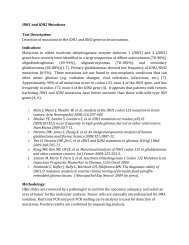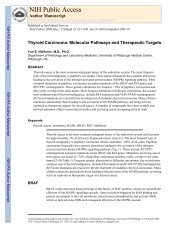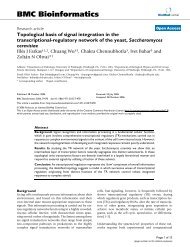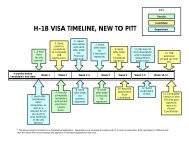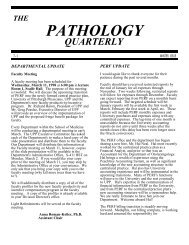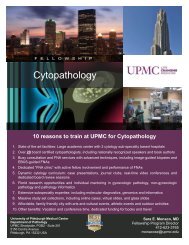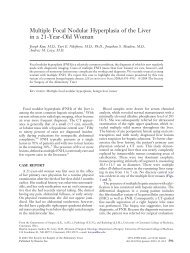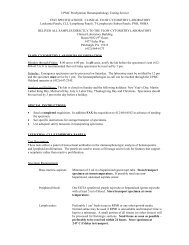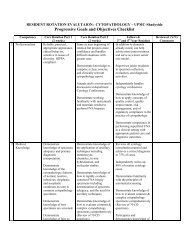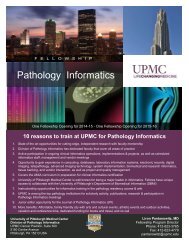Hematopathology Resident / Fellow Manual - Department of ...
Hematopathology Resident / Fellow Manual - Department of ...
Hematopathology Resident / Fellow Manual - Department of ...
Create successful ePaper yourself
Turn your PDF publications into a flip-book with our unique Google optimized e-Paper software.
Continuing Education in Clinical Chemistry and Hematology<br />
Description:<br />
The Continuing Education Conference is organized around a case discussion (resident) and<br />
scientific issue or laboratory management/quality assurance presentation (faculty). A method or<br />
technical issue may also be presented by a lead technologist. Coordination between the 2-3<br />
presenters is encouraged. The sessions are targeted toward technologist education. Discussion<br />
between pathologists/trainees and technologists is encouraged. Periodic updating <strong>of</strong> important<br />
basic concepts is welcome. Please seek input from Dr. Contis, or another hematopathologist when<br />
planning your hematology presentation.<br />
Day, time and location:<br />
Tuesdays at 9:15 -10:15 AM (following the residents' lectures), unless the resident lectures times<br />
are changed. The location is usually CLB Room 1021.<br />
Frequency <strong>of</strong> presentation: Each resident on the laboratory hematology rotation will present<br />
once, usually on the last week <strong>of</strong> their rotation.<br />
Length <strong>of</strong> each presentation: 15-20 minutes<br />
Examples <strong>of</strong> Topics:<br />
1. Case discussion (<strong>Resident</strong> or fellow).<br />
a. “Atypical lymphocytes,” 9/4/07, Dr. A. Henry<br />
b. “Case <strong>of</strong> G6PD deficiency,” 9/25/07, Dr. I Batal<br />
c. “Identification <strong>of</strong> urinary crystals,” 10/16/07, Dr. M. Rollins-Raval<br />
d. “Nucleated Red Blood Cells and the Coulter LH 750 and the Sysmex XE 2100,”<br />
12/16/08, Dr. Hannah Kastenbaum<br />
e. "Scaling the Peaks: High-Performance Liquid Chromatography And the Detection <strong>of</strong><br />
Hemoglobin S", 5/5/09, Dr. Milon Amin<br />
f. “Cystine crystals,” 12/12/10, Dr. Kelley Garner<br />
2. Method or technical issue (Lead technologist or other)<br />
a. “Validation <strong>of</strong> reference ranges for automated ESR method.” 9/4/07, E. Austin<br />
b. “Review and tips for making thick smears for blood parasites,” P. Nowack<br />
c. “Review <strong>of</strong> PFA-100,” 9/9/08, Dr. S. Monaghan<br />
d. “Review <strong>of</strong> Bronchoalveolar Lavage (BAL) Analysis for Cell Counts & Differentials,<br />
12/2/08,” Dr. S. Gibson<br />
e. “A Proposed Plan for the Comparison Evaluation <strong>of</strong> the Coulter DxH 800, Sysmex<br />
XE, and Coulter LH 750,” Dr. S. Monaghan<br />
3. Scientific issue, quality assurance or management (Faculty)<br />
a. Discuss a method, disease, recent literature, QA study, etc.<br />
b. “Immature reticulocyte fraction,” 10/21/08,” Dr. L. Contis<br />
c. “Automated Cell Counts on Pleural Fluid: Review <strong>of</strong> a Study on the Sysmex XE-<br />
2100, 12/2/08,” Dr. R. Felgar.<br />
d. “Platelet Counting by the Coulter LH 750 and Sysmex XE 2100,” 12/16/08, Dr. S.<br />
Monaghan



